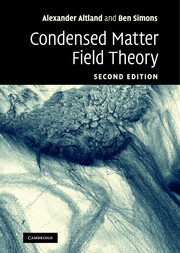Book contents
- Frontmatter
- Contents
- Preface
- 1 From particles to fields
- 2 Second quantization
- 3 Feynman path integral
- 4 Functional field integral
- 5 Perturbation theory
- 6 Broken symmetry and collective phenomena
- 7 Response functions
- 8 The renormalization group
- 9 Topology
- 10 Nonequilibrium (classical)
- 11 Nonequilibrium (quantum)
- Index
7 - Response functions
Published online by Cambridge University Press: 04 August 2010
- Frontmatter
- Contents
- Preface
- 1 From particles to fields
- 2 Second quantization
- 3 Feynman path integral
- 4 Functional field integral
- 5 Perturbation theory
- 6 Broken symmetry and collective phenomena
- 7 Response functions
- 8 The renormalization group
- 9 Topology
- 10 Nonequilibrium (classical)
- 11 Nonequilibrium (quantum)
- Index
Summary
The chapter begins with a brief survey of concepts and techniques of experimental condensed matter physics. It will be shown how correlation functions provide a bridge between concrete experimental data and the theoretical formalism developed in previous chapters. Specifically we discuss – an example of outstanding practical importance – how the response of many-body systems to various types of electromagnetic perturbation can be described in terms of correlation functions and how these functions can be computed by field theoretical means.
In the previous chapters we have introduced important elements of the theory of quantum many-body systems. Perhaps most importantly, we have learned how to map the basic microscopic representations of many-body systems onto effective low-energy models. However, to actually test the power of these theories, we need to understand how they can be related to experiment. This will be the principal subject of the present chapter.
Modern condensed matter physics benefits from a plethora of sophisticated and highly refined techniques of experimental analysis including the following: electric and thermal transport; neutron, electron, Raman, and X-ray scattering; calorimetric measurements; induction experiments; and many more (for a short glossary of prominent experimental techniques, see Section 7.1.2 below). While a comprehensive discussion of modern experimental condensed matter would reach well beyond the scope of the present text, it is certainly profitable to attempt an identification of some structures common to most experimental work in many-body physics.
- Type
- Chapter
- Information
- Condensed Matter Field Theory , pp. 360 - 408Publisher: Cambridge University PressPrint publication year: 2010



